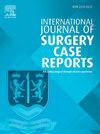波特病并发腹膜后巨大结核性肿块1例。
IF 0.6
Q4 SURGERY
引用次数: 0
摘要
介绍和重要性:结核病仍然是一个重大的公共卫生问题,特别是在发展中国家,由于过度拥挤和免疫抑制等因素,其发病率正在上升。在肺外结核形式中,腹部结核是常见的,而腹膜后结核是罕见的,由于其与其他腹膜后肿瘤相似,往往难以诊断。诊断通常需要侵入性手术,如腹腔镜检查或剖腹手术。病例介绍:我们报告一例45岁的妇女波特病导致一个大的腹膜后结核性脓肿。她表现为右侧肿块,慢性腰痛,体重减轻,发烧。影像学显示L1-L2椎体椎间盘炎和腹膜后收集。PCR证实为结核分枝杆菌。治疗包括脓肿引流和9个月的抗结核方案。临床讨论:腹膜后结核表现为非特异性症状,常延误诊断。影像学在鉴别脓肿中起着至关重要的作用,CT和MRI是关键工具。腹膜后结核性脓肿的治疗包括手术引流和长期抗结核治疗。早期诊断和多学科方法对于治疗这种严重的肺外结核至关重要。结论:腹膜后结核性脓肿虽然罕见,但却是肺外结核的一种严重形式,需要提高临床警惕。本文章由计算机程序翻译,如有差异,请以英文原文为准。
Pott's disease complicated by a large retroperitoneal tuberculous mass: A case report
Introduction and importance
Tuberculosis (TB) remains a significant public health issue, especially in developing countries where its incidence is rising due to factors like overcrowding and immunosuppression. Among extrapulmonary TB forms, abdominal TB is common, while retroperitoneal TB is rare and often challenging to diagnose due to its similarity to other retroperitoneal tumors. Diagnosis typically requires invasive procedures such as laparoscopy or laparotomy.
Case presentation
We report the case of a 45-year-old woman with Pott's disease leading to a large retroperitoneal tuberculous abscess. She presented with a right flank mass, chronic low back pain, weight loss, and fever. Imaging revealed spondylodiscitis at the L1-L2 vertebrae and a retroperitoneal collection. PCR confirmed Mycobacterium tuberculosis. Treatment involved abscess drainage and a 9-month anti-TB regimen.
Clinical discussion
Retroperitoneal TB presents with non-specific symptoms, often delaying diagnosis. Imaging plays a crucial role in identifying abscesses, with CT and MRI being key tools. The treatment of retroperitoneal tuberculous abscesses includes surgical drainage and prolonged anti-tuberculosis therapy. Early diagnosis and a multidisciplinary approach are essential to managing this severe form of extrapulmonary TB.
Conclusion
Retroperitoneal tuberculous abscesses, though rare, represent a severe form of extrapulmonary tuberculosis that requires increased clinical vigilance.
求助全文
通过发布文献求助,成功后即可免费获取论文全文。
去求助
来源期刊
CiteScore
1.10
自引率
0.00%
发文量
1116
审稿时长
46 days

 求助内容:
求助内容: 应助结果提醒方式:
应助结果提醒方式:


